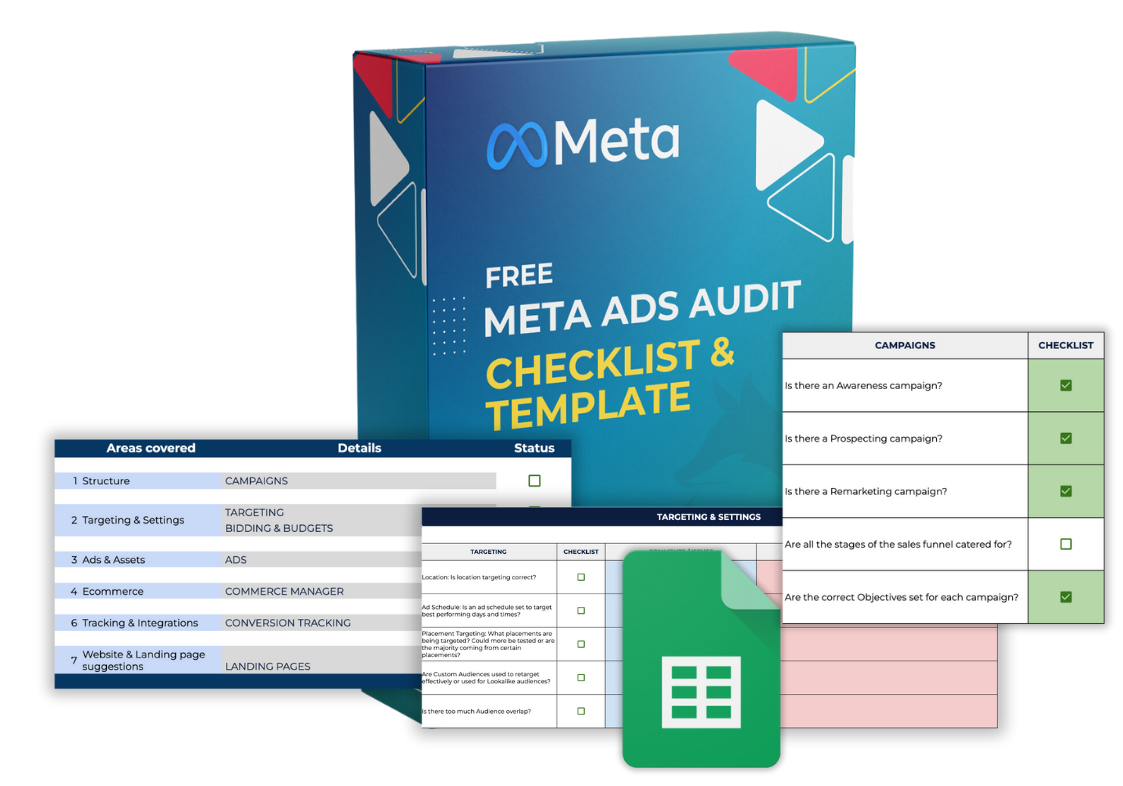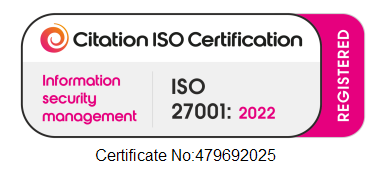Are you running ads on Meta (Facebook and/or Instagram) and unsure if your campaigns are set up for success? We have the perfect tool for you; our comprehensive Facebook (Meta) Ads Audit Checklist and Template.
Meta ads can run across both Facebook and Instagram, which together boast a whopping 3 billion users worldwide. If you’re wondering if your target market is using these platforms, the answer is yes. But a strategic and structured approach to your campaigns is vital to ensure you’re not wasting marketing spend.
Conducting an audit of your Meta campaigns is essential in understanding what you’re missing, what’s working well and what could be improved or tested. Our Facebook (Meta) Ads Audit Checklist and Template breaks down all of the elements you need to thoroughly investigate your campaigns, from the structure and tracking right down to the ads themselves.
So let’s get into it! Download the checklist now, and read below for further insights on each section of the checklist.
In this post
What is a Facebook Meta Ads Audit?
A Meta Ads Audit is an in-depth analysis of your ad account set up and past and presently running campaigns. An audit typically uncovers both the good and bad, identifying successes but, most importantly, areas in need of improvement.
An audit helps you to make informed and data-driven decisions to achieve your paid social goals. Whether that’s to increase Return on Ad Spend (ROAS), lower Cost per Lead (CPL) or increase awareness.
Following our Meta Ads Audit Checklist & Template
Below we’ve detailed each section of our Meta Ads Audit Checklist and Template, giving you everything you need to complete a thorough audit. If you are running Google Ads along with Meta ads, you might find it beneficial to check out our blog How to do a PPC Audit with checklist and template..
But first things first…
Before you get started on the audit, have you decided on your goals? What do you want to achieve from this audit? What results do you want to see from your Meta campaigns? It could be a ROAS of 3, or a CPL of £20 for example. But it’s vital to make sure your goals are achievable. Review the latest industry benchmarks (this is a great starting point) as well as understanding what you need to achieve in order for Meta ads to be profitable for your business.
Account Structure

Targeting each stage of the funnel
When reviewing the structure of your current campaigns, one of the first things to look for is if each stage of the funnel is catered for. For example, are you running an awareness campaign to target those who haven’t heard of you before? Usually awareness campaigns run with either an objective of reach (to increase brand recall) or website traffic (to drive website visits and build your remarketing audiences). We tend to recommend website traffic to help build your funnel and get users browsing.
Are you also running a prospecting campaign to identify who is likely to be a customer? With prospecting campaigns on Meta, you have a few options – targeting by interests and demographics, letting the system do its magic with Advantage+ targeting, or for e-commerce brands an Advantage+ Shopping campaign. If you haven’t tried Advantage+ in your campaigns, we recommend trialling it, although we recommend a budget of at least £50 a day for these campaigns.
Having a remarketing campaign is highly important, but often overlooked. These campaigns are generally cheaper to run as your audience size is smaller, plus they’ll tend to see the best results. This is because you’re targeting people who have already shown an interest in your brand, either by visiting your website or adding an item to their cart, or opening and not completing a lead gen form.
Remarketing campaigns not only retarget those who found out about your business via meta ads. They also capture those who may have clicked on your Google ads or found you via organic search. They are an absolute must.
Reviewing previous performance
Part of the structure section of the checklist covers reviewing previous campaign performance. The key things to look for in your currently or previously running campaigns are:
- Warnings: Check your campaigns for any warnings or suggestions. For example, some of your campaigns may be in ‘learning limited’, which means your ads are not receiving enough optimisation events to exit the learning phase. This is usually down to either:
- Budget limitations – If this is the case, consider increasing your budgets
- Audience size – If this is the case, consider broadening your targeting
- Bid controls – If this is the case, consider increasing your bid caps (if you have them)
- Lack of data – If this is the case, consider changing your campaign objective/conversion event to be one that has more data to begin with, such as website traffic.
- A/B Tests – Have you run any A/B tests in the account? If not, consider what could be tested in order to understand what is successful. You can test audiences/ad sets, for example, testing a Lookalike audience vs. an Interest-based audience. And you can also test ads themselves, to ensure only your high performing ads are running.
- Highlight Successes: And of course, make sure to review which past campaigns brought you the best results. Why did they work? Was it down to targeting, creative or budget? Or a combination of these things? If you can pinpoint this, you’ll be better informed with your strategy going forward.
Targeting & Budgets
There’s quite a lot to cover in this section, so let’s break each question down:
Targeting
- Location: Is location targeting correct? It may sound simple, but have you set specific target locations for your campaigns? Unless you’ve got a really healthy budget, often targeting a whole country will mean your budget will be spread too thin. Review which cities or areas your customers come from and consider targeting those. And if there are regions where you find you’re getting traffic and you don’t want it, ensure you add those as exclusions, just in case.
- Ad Schedule: Is an ad schedule set to target best performing days and times? We don’t tend to use ad scheduling unless there’s a really obvious reason to. For example, you are McDonald’s and want to advertise the breakfast menu, so may run your ads from 4am-11am. You are only able to run ad scheduling with a Lifetime Budget set.
- Placement Targeting: What placements are being targeted? Use the ‘Breakdown’ section on Ads Manager to review where your ads are being served and where your ads are seeing results. If you spot that most conversions are coming from Instagram instead of Facebook, consider only targeting Instagram.
- Are Custom Audiences used to retarget effectively or used for Lookalike audiences? Custom audiences are becoming more important as Meta continues to reduce the interest targeting options available to advertisers. Not to mention the phase out of third-party cookies. Custom audiences can be used for remarketing, as well as to build Lookalike audiences to target potential customers. Custom audiences could include website visitors and social engagers for remarketing campaigns for example. And you could build a Lookalike audience based on website visitors and social engagers to find ideal prospective customers.
- Is there too much Audience overlap? If you’re running campaigns to a few different audiences, it’s important that they don’t have too much overlap. If there is a high percentage of overlap, you’ll essentially be running 2 campaigns to the same people, and therefore wasting spend, or worse, bidding against yourself. Meta has a great tool to check your campaigns potential overlap. To get to it, go to ‘Audiences’ and tick the boxes next to the audiences you want to compare (you can tick up to 5). Then click on ‘Actions’ and ‘Show Audience Overlap’.
- Are both New and Existing customers targeted? Of course it’s important to target new customers via awareness campaigns. But are you also targeting your existing customers? If your business often has repeat customers, it’s vital to ensure you run ads to existing customers to encourage them to buy again. An existing customer audience can be built as a Custom Audience.
- Are target audiences broad enough? As mentioned previously, if your audiences aren’t broad enough, you’ll face the risk of your campaigns going into ‘Learning Limited’. Ensure your audience size is large enough to avoid this.
- Are exclusions used? There are lots of ways exclusions can be used, but here is an example: In your awareness campaign, you ideally only want to target people who have never heard of you before. Therefore to do this, you should exclude your purchasers/leads, website visitors and social engagers from your targeting.
- If interests/demographics are targeted, are they as relevant as they can be? Again, it sounds simple, but really digging deeper into what your customers care about will help with interest targeting. If you sell eco-friendly products, think about targeting eco-friendly related interests as well as product-related interests for example.
- Can interest or demographics-based ad sets be split out into their own ad sets for more relevant ads? The more relevant your ads are to your target market, the better. For example, say you sell organic children’s clothing. You could test splitting your ad sets out into: 1. Mums with children, 2. Women aged 25+ with Organic-related interests and 3. Women aged 25+ with competitor brand interests. This will enable you to tailor your creatives and messaging to each audience.
Budgets
- Is a cost per result goal assigned to campaigns? If there is, consider if it’s high enough to yield the results you are looking for. If there isn’t, consider adding one if you know the maximum and ideal cost per result you’re after.
- What attribution settings do the campaigns use? An attribution window is the number of days between when a user viewed, clicked or played your ad, and then took action. The automatic attribution setting for Meta ads is 1-day view and 7-day click, and we’d recommend keeping this as best practice.
- Is enough daily budget set for each campaign? A clear indicator of too low of a budget is your campaigns being in ‘learning limited’. And a clear indicator of your budget being too high is usually a high ad frequency, and this is typically because your audience size is too small. Consider broadening the audience in this case.
- Is Advantage+ Budget turned on on any campaigns or manual budgets? Advantage+ budget is set at the campaign level, and allows the system to spread your budget across your ad sets based on results. For example, if one of your ad sets is seeing a higher CTR or ROAS, the system will push more budget towards this ad set automatically.
Ads and Assets
Even if you’ve nailed your structure and targeting, if your ads don’t resonate, you just won’t see results. So, here’s what to review when it comes to your ads:
- Are any ad optimisations used? In recent months Meta has been introducing more and more ad optimisation tools, many of which use AI. You’ll find these at the ad level under ‘Advantage+ Creative’. Some are brilliant and others… not so. For example, ‘Add Catalogue Items’ will automatically detect products used in your assets, and show these underneath, which works great to entice purchases. You can add music to images or videos here too, as well as allow the system to move ad text around based on what the user is more likely to respond to. Although some optimisations are still not great, and can potentially have a negative impact on brand image. For example, Image Template can add text on top of your creative, and Expand Image will add backgrounds to your ads to fit different screens. Use these with caution!!
- Are dynamic product ads used? If you’re an ecommerce brand, dynamic product ads are a fantastic tool. Typically used at the remarketing stage, they automatically show the products users have been looking at (plus others that are relevant) in a carousel. Each carousel card links directly to the product, and makes for a seamless buying experience.
- Have different ad types been tested? Ad types can include video, image/GIF, or collection. We recommend testing each to see if your audience resonates with some better than others.
- Does each campaign have 5+ ads? We highly recommend that for each ad set you try to run with 5 or more ads. Doing this will allow you to see what’s working, but also the system will automatically show your higher performing ads more to improve results.
- Could the ad messaging be improved? There is no one-size-fits-all when it comes to ad messaging. Although, there are some best practices to test, such as:
- Clear CTA – Ensure your call to action is prominent. What do you want people to do? Shop now? Claim offer? Book appointment? Make sure your CTA is in the heading and in the first few lines of your ad copy.
- Use ‘you’ and ‘your’ language – Speak to the user and make them feel like the brand is speaking to them.
- PAS method – Start with the problem (P) your customers face. Then highlight the agitation (A) they feel with this problem. And then hit them with the solution (S); i.e. your product.
- How high (or low) is the ad frequency? Be sure to keep an eye on ad frequency for each campaign. This number is the average amount of times any one person sees your ad. For awareness and prospecting campaigns, this number should be between 1 and 3. If it goes much above this, you may start to see ad fatigue, or even worse people may report your ads if they are shown to them too much. For remarketing campaigns, it’s normal for your ad frequency to be a little higher as the audience size is smaller. But still monitor this and ensure it doesn’t go much above 8.
- Are any ads disapproved? If you have any ads disapproved, what is the reason given? Your ads will go through an automatic checker, and sometimes they can be incorrectly flagged and disapproved. As long as your ads adhere to the Meta Advertising Standards, you can submit your ads to be reviewed manually.
- What URLs are being used on ads? Check where users are taken to once they click on your ads. If your ad is about a specific product, ensure to take them to the product page instead of the home page to make it easy for them to purchase. And if you want to understand how people who click on your meta ads use your website, consider using UTMs.
- Is the correct Tracking chosen for each ad? At the ad level, ensure that the correct pixel is ticked to track activity to and from your website.
Ecommerce
There’s a little more work to do if you’re an ecommerce business. To run ads that utilise products from your website, such as dynamic product ads or isolating specific product sets, you’ll need to ensure you have synced your website shop with Commerce Manager.
Within Business Manager you’ll see the tool ‘Commerce Manager’. You can sync your product feed with Commerce Manager (e.g. via Shopify or WooCommerce), and easily create your catalogue and group together product sets to use in your ads. If you’ve already synced up your products, make sure there are no errors showing in Commerce Manager and all your products are showing as they should.
Tracking & Integrations

Now you’ve got your structure, targeting, budgets and ads in a better position, are you correctly tracking events? One of the most fundamental items in the checklist, and one that we often see issues with.
There are two ways to track events from your meta ads, and these are:
- Meta Pixel: This is a piece of code that is placed on your website and means you can measure the actions people take on your website after they’ve engaged with your ads.
- Conversions API: This is a direct connection and a more reliable connection between meta and your website.
Using both together will mean your tracking is more accurate, and your event match quality will be higher. And inevitably better ad performance as you optimise towards these events!
Future Strategy Planning
Well done, you’ve now completed a comprehensive audit of your Meta ads! You should now be equipped with all the data you need to put together a strategy for testing, optimisation and growth.
It’s important to say that an audit of your meta ads shouldn’t be a one-off activity. Tools, algorithms and trends change, so we recommend auditing your campaigns every quarter and feed your findings back into your strategy.
Free Meta Ads Audit with Checklist & Template













